Overview
This article highlights ten virtual collaboration tools that can significantly boost productivity for startups. From Casy's automation capabilities to Slack's communication enhancements, each tool boasts unique features designed to streamline workflows and improve team collaboration. By leveraging these tools, startups can focus on innovation instead of getting bogged down by administrative tasks.
Consider how these tools can transform your startup's operations. Are you struggling with communication or workflow efficiency? The right collaboration tools can alleviate these challenges, fostering a more innovative environment.
Ultimately, adopting these tools not only enhances productivity but also empowers teams to work smarter. By integrating such solutions, startups can prioritize their core mission—driving innovation and growth in a competitive landscape.
Introduction
The rise of remote work has fundamentally transformed how startups operate, making effective collaboration tools more essential than ever. In this dynamic landscape, leveraging the right virtual collaboration tools can significantly boost productivity and streamline workflows. However, with a multitude of options available, how can startups identify which tools will genuinely enhance their operational efficiency and foster innovation? This article explores ten standout virtual collaboration tools that promise to elevate startup productivity, offering insights into their unique features and benefits.
Casy: Automate Project Management and Task Creation
Casy operates as an invisible project manager, seamlessly integrating with platforms like Slack and Telegram to capture essential information from conversations. By automatically generating assignments, establishing deadlines, and revising documents, Casy significantly decreases manual input and improves group productivity. Its features, including automated assignment creation and personal weekly scheduling, categorize activities into areas such as R&D, Bugs, and In Progress, ensuring full visibility for group members. This functionality is particularly beneficial in fast-paced environments like new ventures and game development, where efficiency is paramount.
Consider the impact on startups using Casy: they can optimize their workflows, allowing teams to focus on innovation rather than administrative tasks. Industry experts note that embracing automation can save founders up to 30 hours per week, enabling them to concentrate on strategic growth. Moreover, AI tools are reported to double productivity across departments, reinforcing the effectiveness of automation in enhancing overall performance.
Casy exemplifies this trend by providing a robust solution that simplifies project management and incorporates virtual collaboration tools to foster a culture of productivity among team members. Additionally, Casy employs methodologies such as OKRs and the Eisenhower Matrix, helping teams prioritize their work efficiently and ensuring that essential tasks are addressed promptly. With a strong commitment to data privacy and security, Casy alleviates significant concerns for startups adopting new tools, making it a reliable choice for those seeking to enhance their operational efficiency.
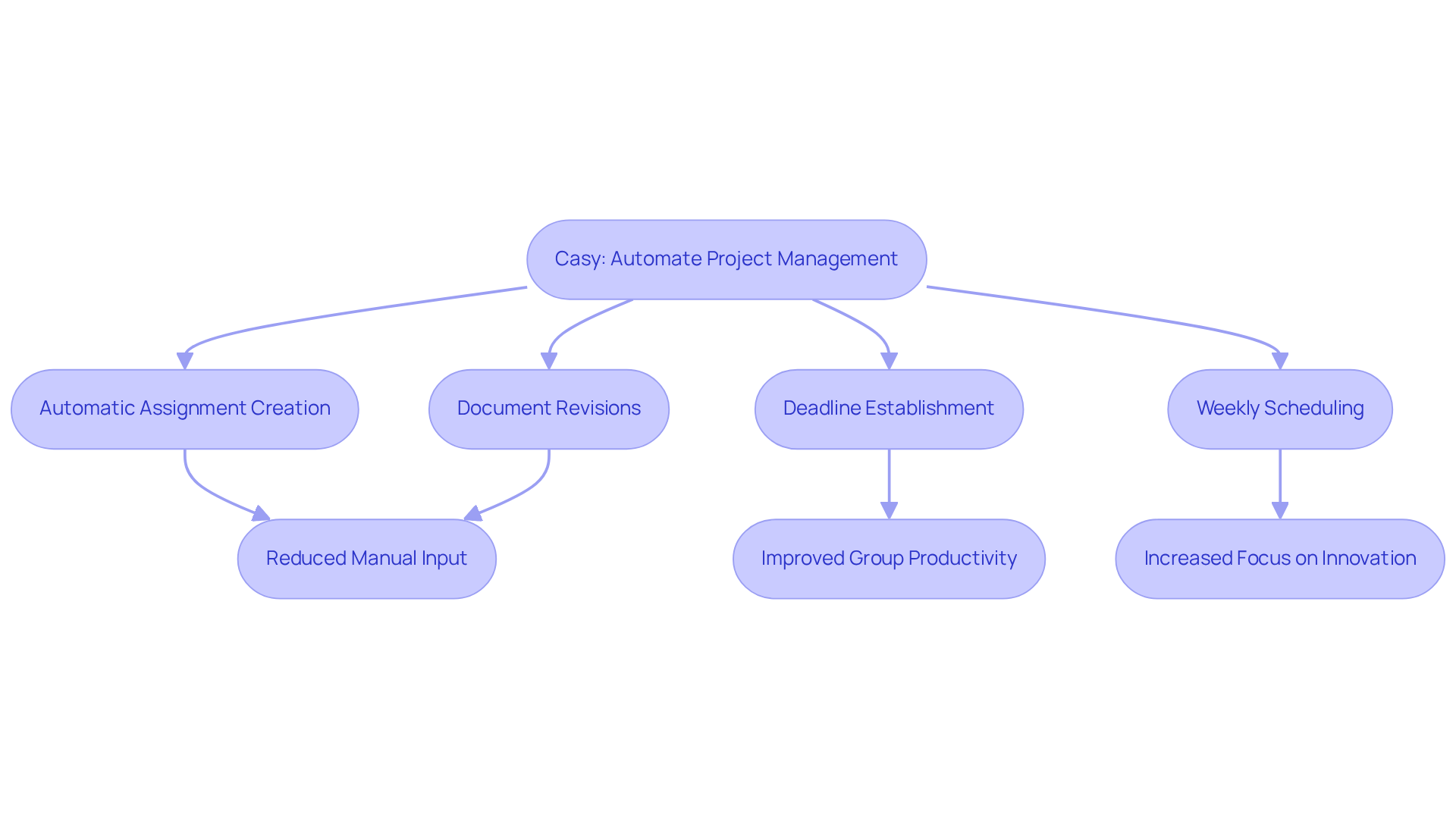
Slack: Enhance Team Communication and Collaboration
Slack serves as a centralized hub for group communication, streamlining organized discussions through channels and direct messaging. Its robust integration capabilities with over 6,400 applications significantly enhance productivity, allowing teams to automate workflows and share files effortlessly. Notably, features like Slack Huddles enable quick, impromptu meetings, while customized workflows optimize repetitive tasks, establishing Slack as an essential virtual collaboration tool for emerging businesses aiming to foster clear communication and collaboration among remote teams.
The impact of Slack on productivity is undeniable. Research shows that teams utilizing the platform experience a 40% increase in productivity, exemplified by the Spotify advertising group, which achieved this by reducing unnecessary meetings and emails. Moreover, startups that adopt Slack report deal cycles that are four times faster and ticket resolutions that are three times quicker, thus boosting overall operational efficiency. As we look ahead to 2025, Slack continues to innovate, introducing features like Tableau Next and Salesforce channels that further bolster collaboration among teams, ensuring they remain agile and connected in an increasingly remote work landscape. Additionally, Slack is projected to surpass 42.7 million daily users by 2025, highlighting its growing significance in the market.
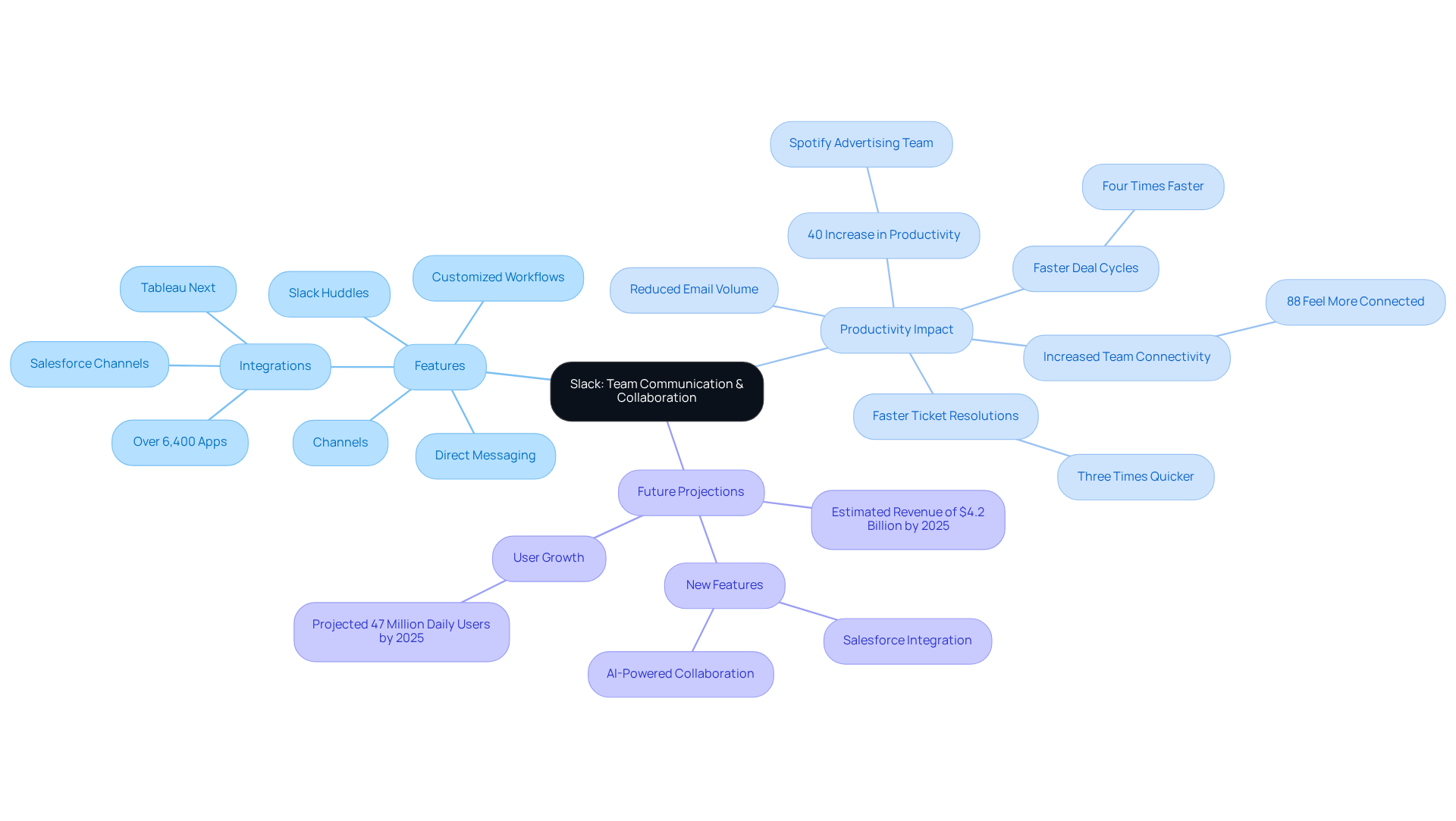
Asana: Streamline Task Management and Project Tracking
Asana stands out as a robust platform for task management, empowering teams to break down initiatives into manageable tasks, assign clear responsibilities, and establish deadlines. With its visual task tracking features—including Kanban boards and Gantt charts—Asana offers unparalleled clarity on progress. Moreover, its ability to integrate seamlessly with other tools enhances its functionality, making it an ideal choice for startups eager to optimize their management processes. Are you ready to elevate your team's productivity and streamline your workflow?

Trello: Visualize Projects and Manage Tasks Efficiently
Trello employs a card-oriented system that empowers teams to visualize their workflows and activities with remarkable efficiency. Users can establish dedicated boards for various initiatives, add cards representing individual tasks, and seamlessly transition them through different stages of completion. This visual methodology not only facilitates task prioritization but also significantly enhances team collaboration through virtual collaboration tools. With over 100 customizable board templates tailored for diverse workflows, Trello enables startups to adapt their management experience to meet their unique needs.
The platform’s simplicity and intuitive interface make it especially attractive for new businesses in search of an effective management solution. A survey indicates that 89% of professionals believe organized teammates are the most productive, underscoring the importance of efficient management in fostering team effectiveness. Moreover, startups utilizing Trello in conjunction with Slack have observed a remarkable 32% increase in task completion rates, while simultaneously reducing email usage by as much as 48%. These statistics vividly illustrate the tangible benefits of integrating virtual collaboration tools into operational practices.
As Trello continues to evolve, its latest updates—including AI-driven features that summarize meeting notes and extract due dates from raw text—along with enhanced integrations with tools like Google Calendar, further streamline task management processes. This ongoing evolution positions Trello as an indispensable resource for startups striving to enhance productivity and maintain focus amid the complexities of project management with virtual collaboration tools.
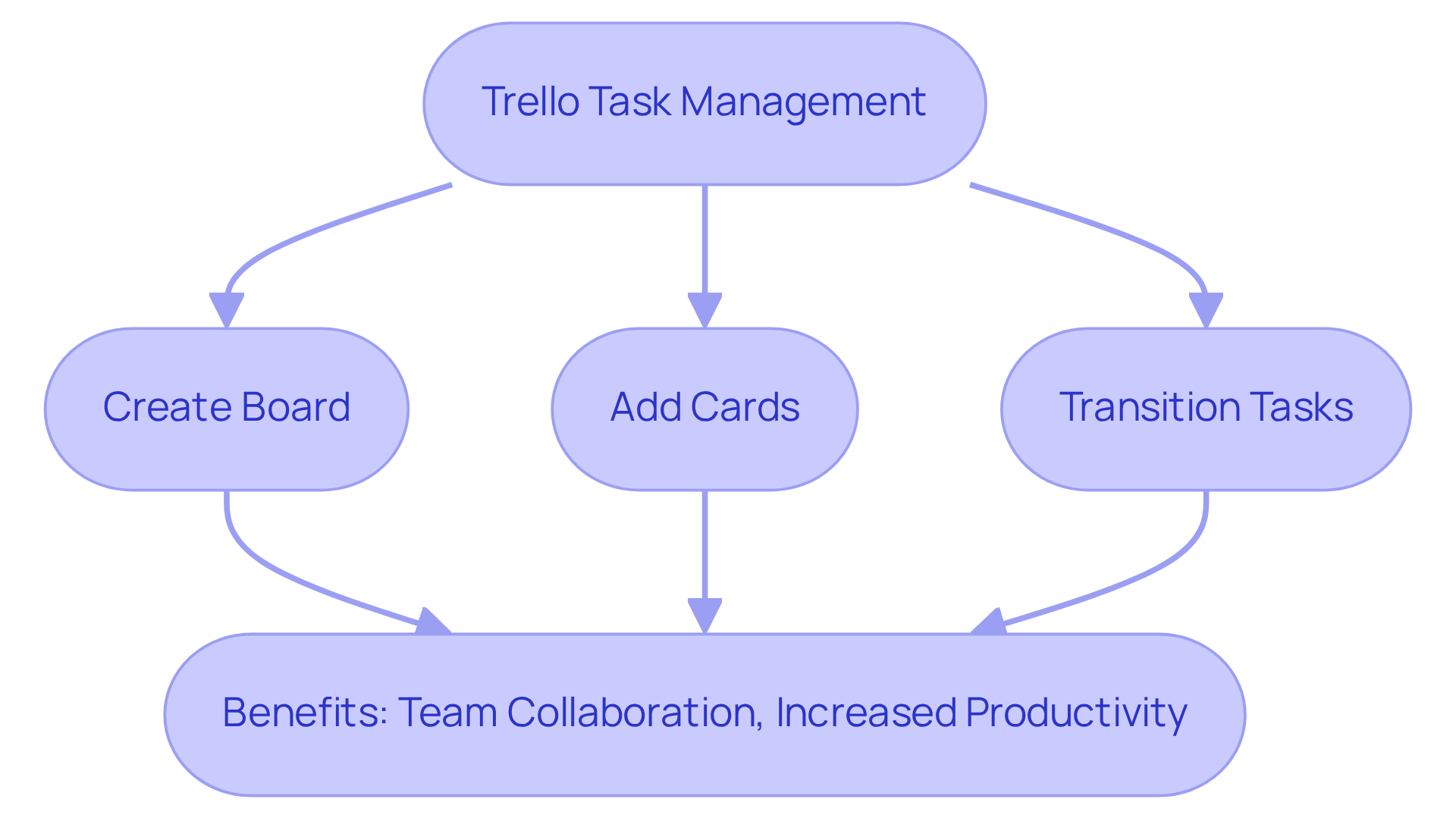
Miro: Collaborate Creatively with Online Whiteboarding
Miro is an example of virtual collaboration tools that provide an online collaborative whiteboard platform, empowering groups to brainstorm, plan, and visualize ideas in real-time. With its infinite canvas and diverse templates, Miro fosters creative collaboration, making it an ideal choice for workshops and group meetings. The platform's seamless integration with other tools enhances its functionality, allowing teams to streamline workflows and maintain alignment on projects.
The impact of virtual collaboration tools, such as Miro, on group brainstorming is significant. By providing a shared space for idea generation, Miro encourages participation from all team members, resulting in richer discussions and innovative solutions. This collaborative approach, especially with virtual collaboration tools, is particularly beneficial for new businesses, where agility and creativity are crucial.
Miro's features support a variety of creative processes, including strategy planning, mind mapping, and flowchart creation, which are essential for startups aiming to develop and refine their ideas. The platform's recognition as a Leader in the IDC MarketScape for Team Collaboration Applications underscores its effectiveness in promoting innovation across organizations, particularly for new businesses focused on enhancing their collaborative efforts through virtual collaboration tools.
Furthermore, Miro's recent launch of the Innovation Workspace on October 8, 2024, an AI-powered platform, significantly boosts its capabilities, enabling teams to transition from ideas to outcomes more efficiently. This initiative reflects the growing trend of integrating AI into collaborative tools, which can dramatically enhance productivity and creativity.
In conclusion, Miro not only provides a robust framework for collaborative brainstorming but also equips new businesses with the necessary resources to thrive in a competitive landscape. By leveraging Miro's capabilities, teams can focus on innovation and development, rather than becoming overwhelmed by management complexities.
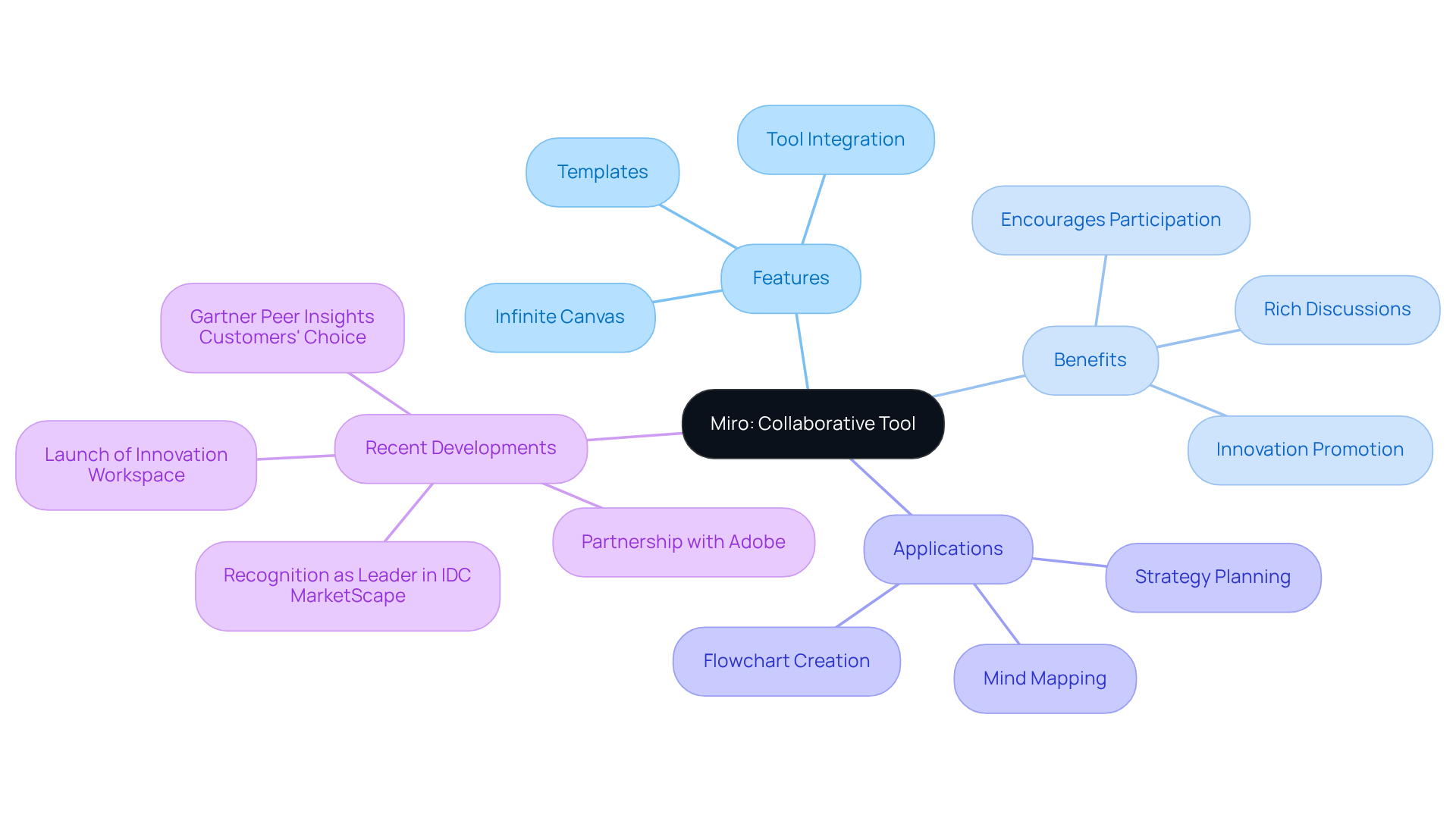
Google Workspace: Collaborate in Real-Time with Integrated Tools
Google Workspace provides an impressive suite of productivity tools, such as Google Docs, Sheets, and Meet, which serve as virtual collaboration tools to empower real-time teamwork. Teams can work simultaneously on documents, share feedback instantly, and seamlessly conduct virtual meetings using virtual collaboration tools within the platform. This integration fosters a cooperative atmosphere through the use of virtual collaboration tools, facilitating project management and enhancing communication for new businesses.
As Ryunosuke Satoro aptly stated, 'Individually, we are one drop. Together, we are an ocean,' emphasizing the transformative power of collaboration in achieving greater outcomes. Furthermore, virtual collaboration tools such as Casy augment Google Workspace by automating assignment creation and updates, addressing common challenges like manual coordination and significantly boosting overall productivity.
Effective groups cultivate collaboration as a mindset rather than a chore. By leveraging virtual collaboration tools like Google Workspace and Casy, startups can optimize workflows and enhance their collective intelligence. Are you ready to elevate your team's productivity to new heights?
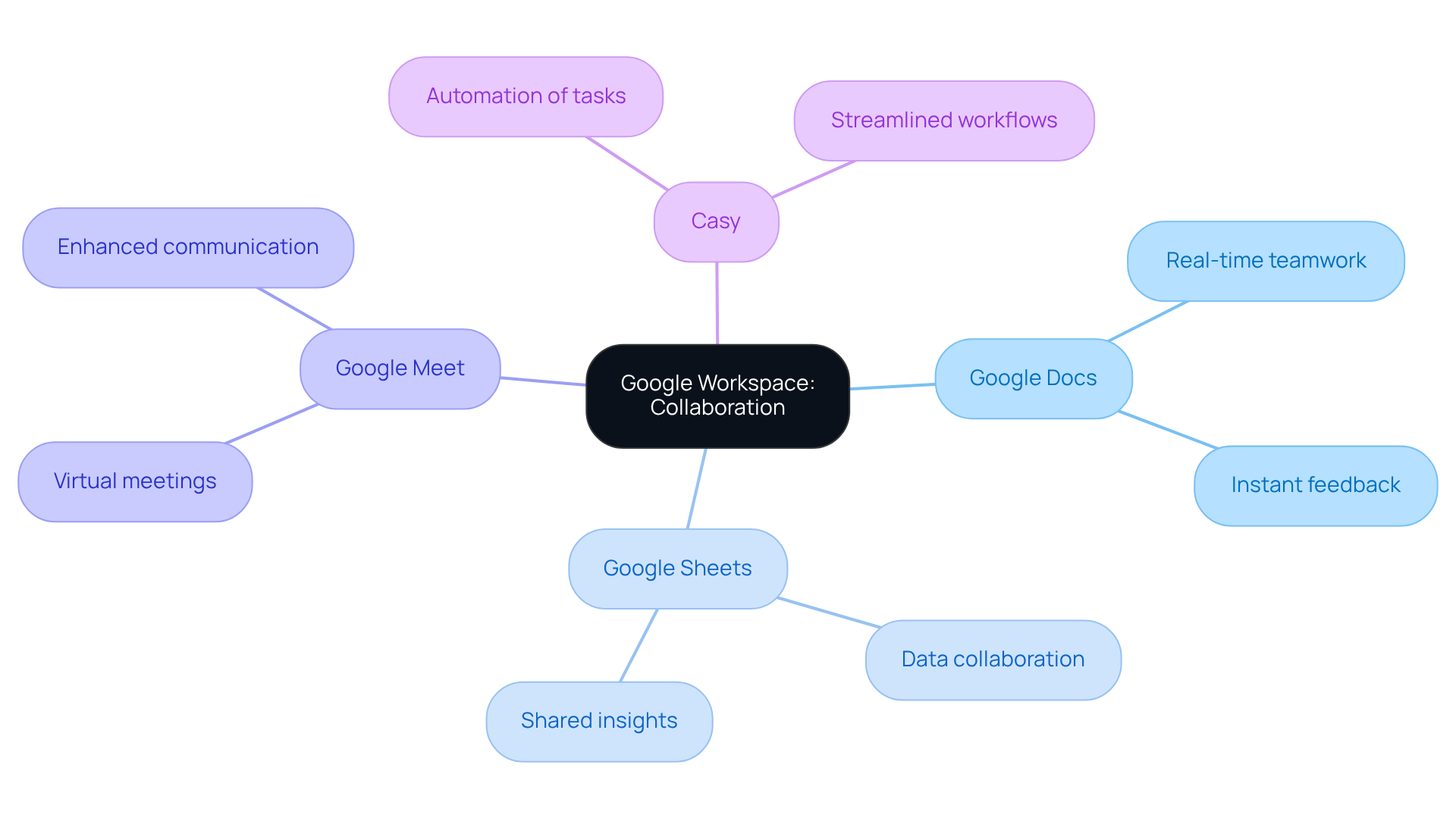
Zoom: Facilitate Virtual Meetings and Team Collaboration
Zoom has established itself as a leading platform for high-quality video conferencing, serving as one of the important virtual collaboration tools for remote teams aiming to enhance collaboration. With features like breakout rooms, screen sharing, and virtual backgrounds, Zoom significantly elevates the meeting experience, fostering a more interactive environment. Consider this: 94% of businesses cite productivity as the primary benefit of video conferencing. Clearly, Zoom's capabilities are essential for maintaining effective communication among dispersed teams.
Moreover, video meetings can reduce travel costs by 30%, offering a substantial financial advantage for startups seeking to optimize expenditures. In fact, 89% of remote workers report feeling more connected when using video conferencing, highlighting the emotional benefits that Zoom brings to group dynamics. The platform's seamless integration with various productivity tools further streamlines workflows, allowing teams to collaborate efficiently, regardless of their physical locations.
As remote work continues to grow, new businesses are finding that virtual collaboration tools, such as Zoom, are indispensable for boosting productivity and enhancing collaboration. To fully leverage these advantages, startup founders should delve into Zoom's features to elevate their team's collaborative efforts. What challenges are you facing in your remote work environment? Exploring Zoom's capabilities could be the key to overcoming them.
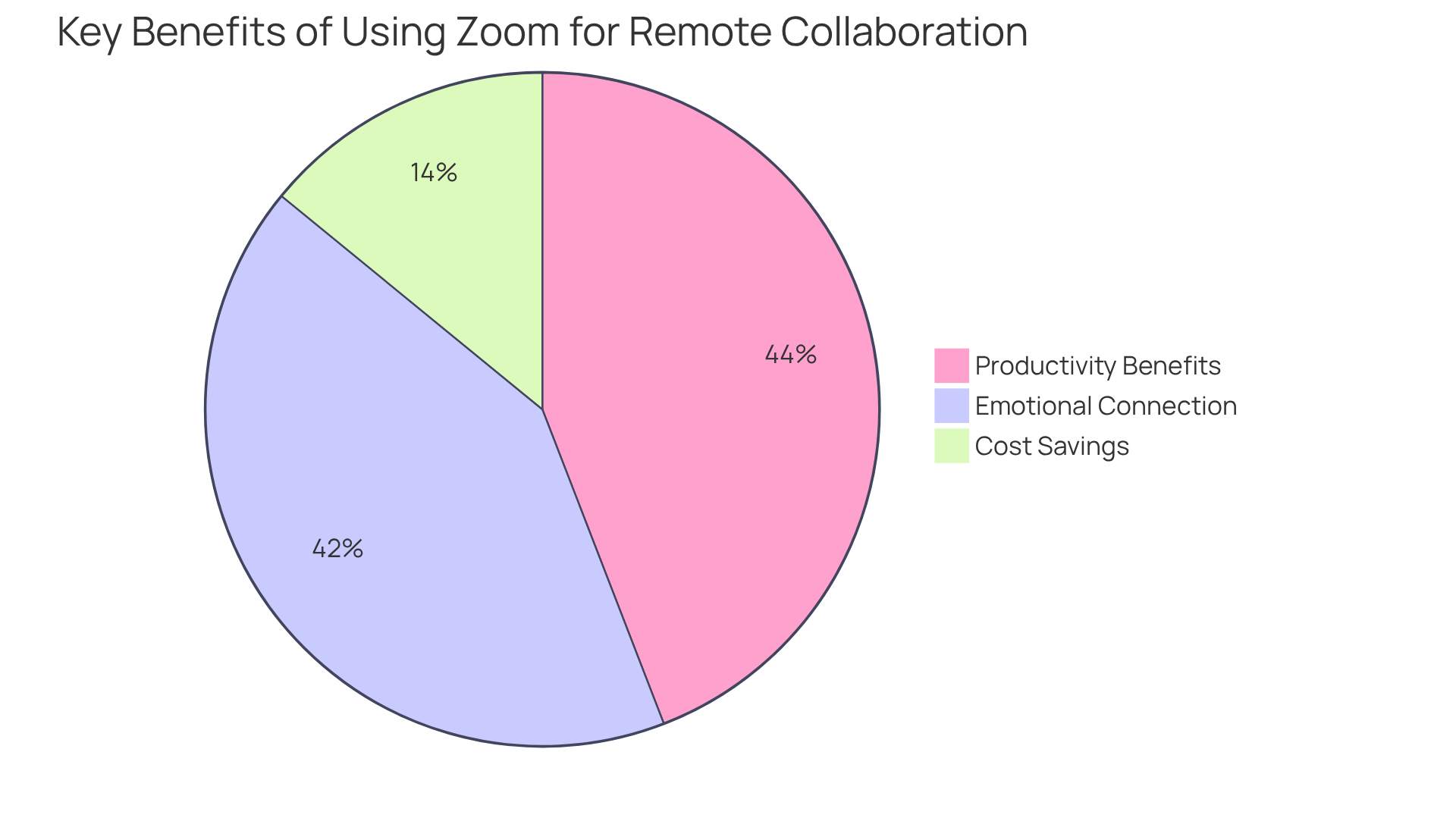
Notion: Organize Workflows and Collaborate in One Place
Notion serves as a comprehensive workspace, enabling teams to organize assignments, documents, and tasks in a single location. With its customizable templates and databases, Notion offers flexible project management tailored to the unique needs of startups.
How can virtual collaboration tools that foster real-time collaboration enhance your team's ability to share ideas seamlessly? Notion’s versatility makes it an optimal choice for new businesses aiming to streamline workflows and boost collaboration through virtual collaboration tools.
By leveraging its features, startup founders can effectively tackle their operational challenges and drive success.
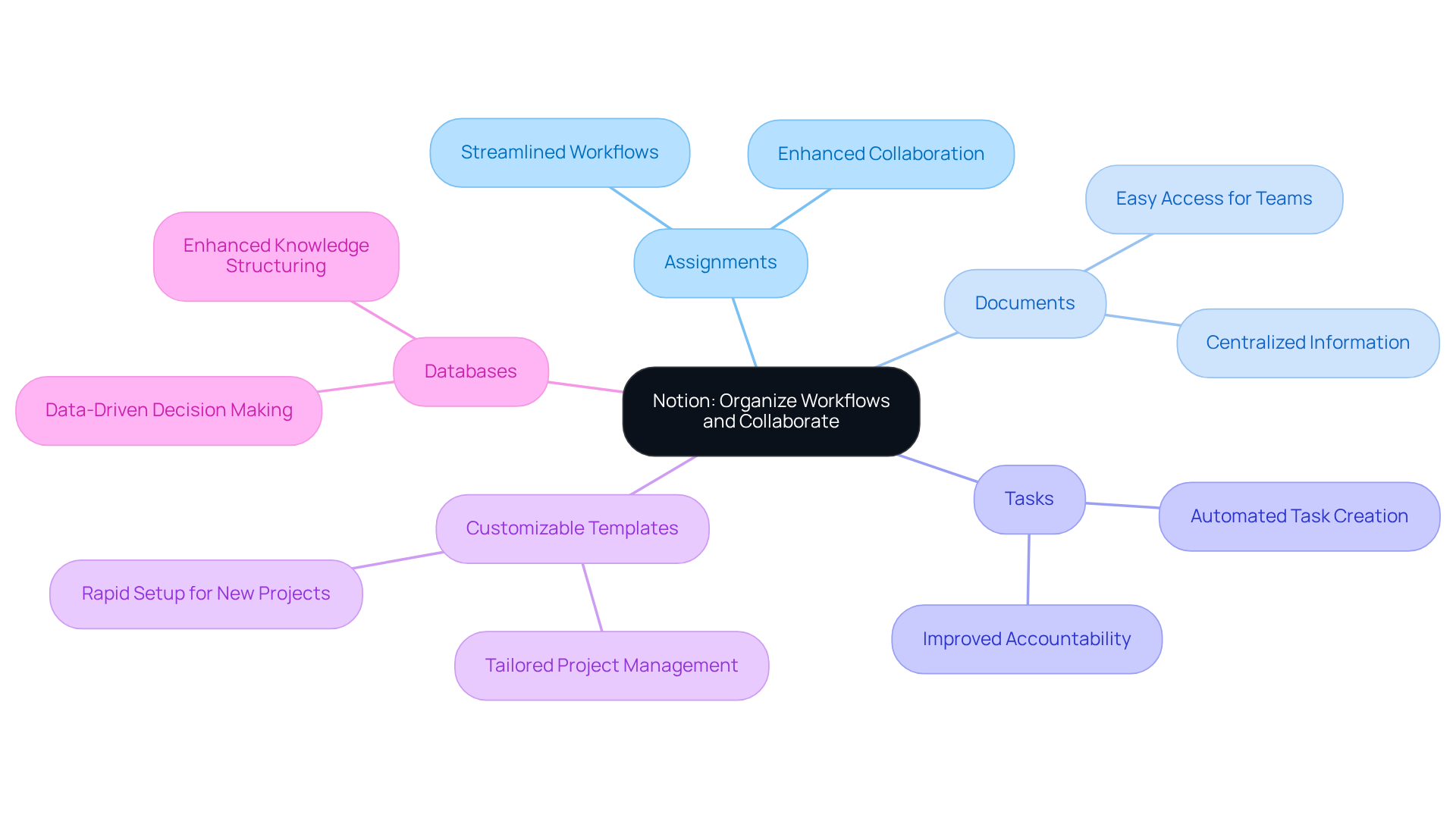
Microsoft Teams: Comprehensive Collaboration and Communication Platform
Microsoft Teams stands as a comprehensive platform utilizing virtual collaboration tools, seamlessly merging chat, video conferencing, and file sharing into one cohesive environment. This integration simplifies communication and significantly boosts productivity, particularly for new businesses. By enabling real-time collaboration on documents through Microsoft 365 tools, Teams empowers users to work together efficiently using virtual collaboration tools, regardless of their location. Features such as threaded discussions and customizable channels foster structured communication, minimizing the risk of miscommunication and workload overload.
Consider this: can you afford to miss out on a tool that hosts online meetings for up to 300 participants for 30 hours and provides 10 GB of cloud storage per user? Microsoft Teams is one of the essential virtual collaboration tools for new businesses aiming to enhance productivity and optimize workflows. Furthermore, its integration with management tools like Casy—capable of capturing key information from conversations and automating task management—enhances the collaborative experience through virtual collaboration tools.
As highlighted by Every Morning Consulting, 'Microsoft Teams Essentials enabled us to weather a difficult business environment and thrive by reducing costs while expanding our reach to new customers.' The platform's unwavering commitment to data encryption ensures that sensitive information remains secure, addressing a critical concern for startups. In a rapidly evolving business landscape, can you afford not to leverage such powerful tools?
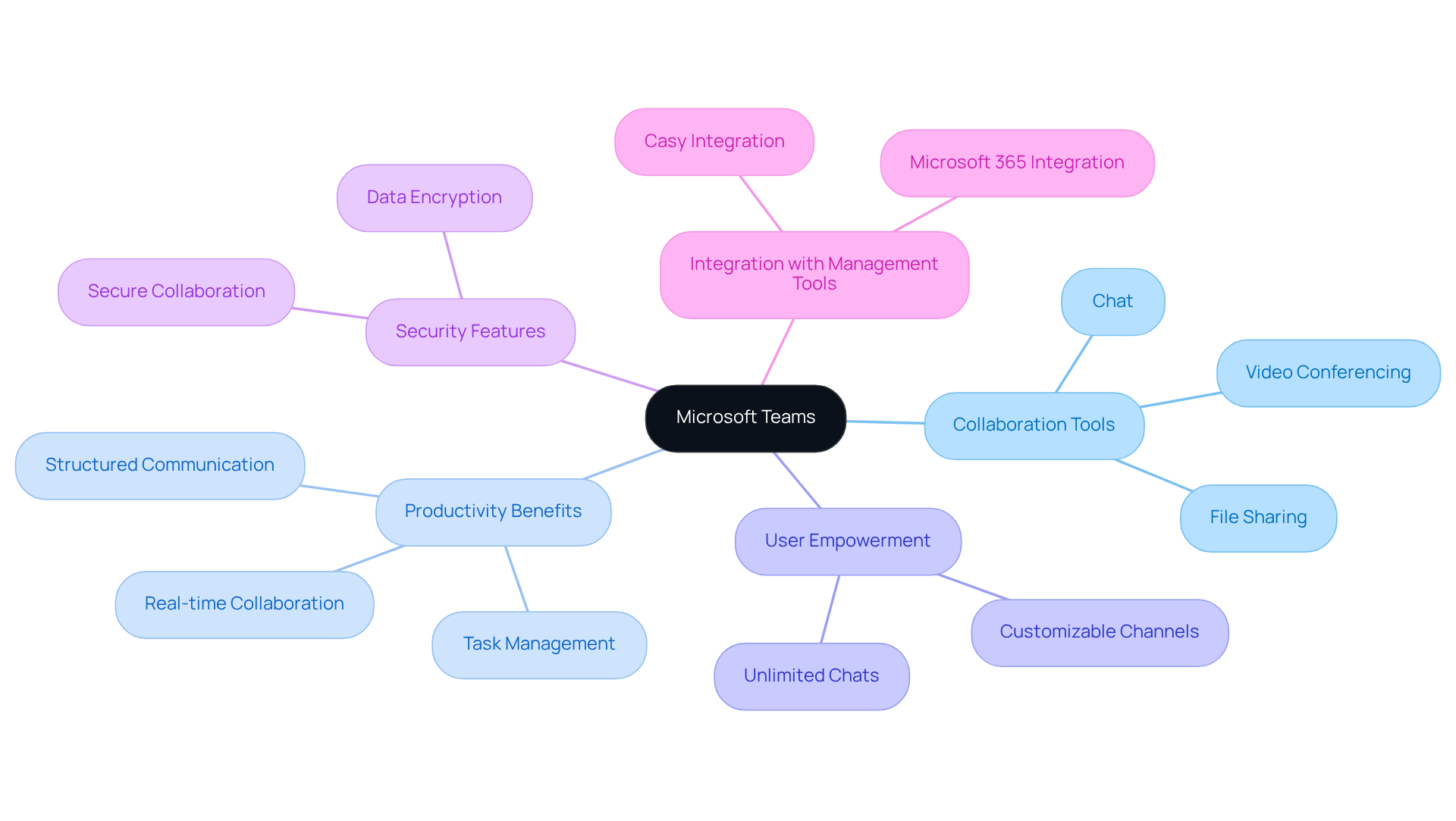
Airtable: Manage Projects with a Flexible Database Approach
Airtable seamlessly combines the accessible characteristics of a spreadsheet with the powerful features of a database. This integration enables groups to oversee tasks and monitor information with exceptional efficiency. With customizable views—including grid, calendar, and Kanban—Airtable provides unmatched flexibility in managing tasks, allowing teams to tailor their workflows to specific requirements.
The platform's virtual collaboration tools enhance effortless teamwork, making it an ideal solution for new businesses aiming to optimize their project processes. But how can you further enhance this efficiency? Enter Casy, which complements Airtable by automating task creation and updates through integration with chat platforms like Slack and Telegram. This functionality significantly reduces administrative overhead.
By leveraging both Airtable's flexible database approach and Casy's automation capabilities, new businesses can enhance their operational efficiency and streamline communication through virtual collaboration tools. Ultimately, this synergy drives productivity. As Robert Heinlein wisely noted, innovation can save significant time and effort in project management. In today's fast-paced environment, tools like Airtable and Casy are not just beneficial; they are essential for modern startups.
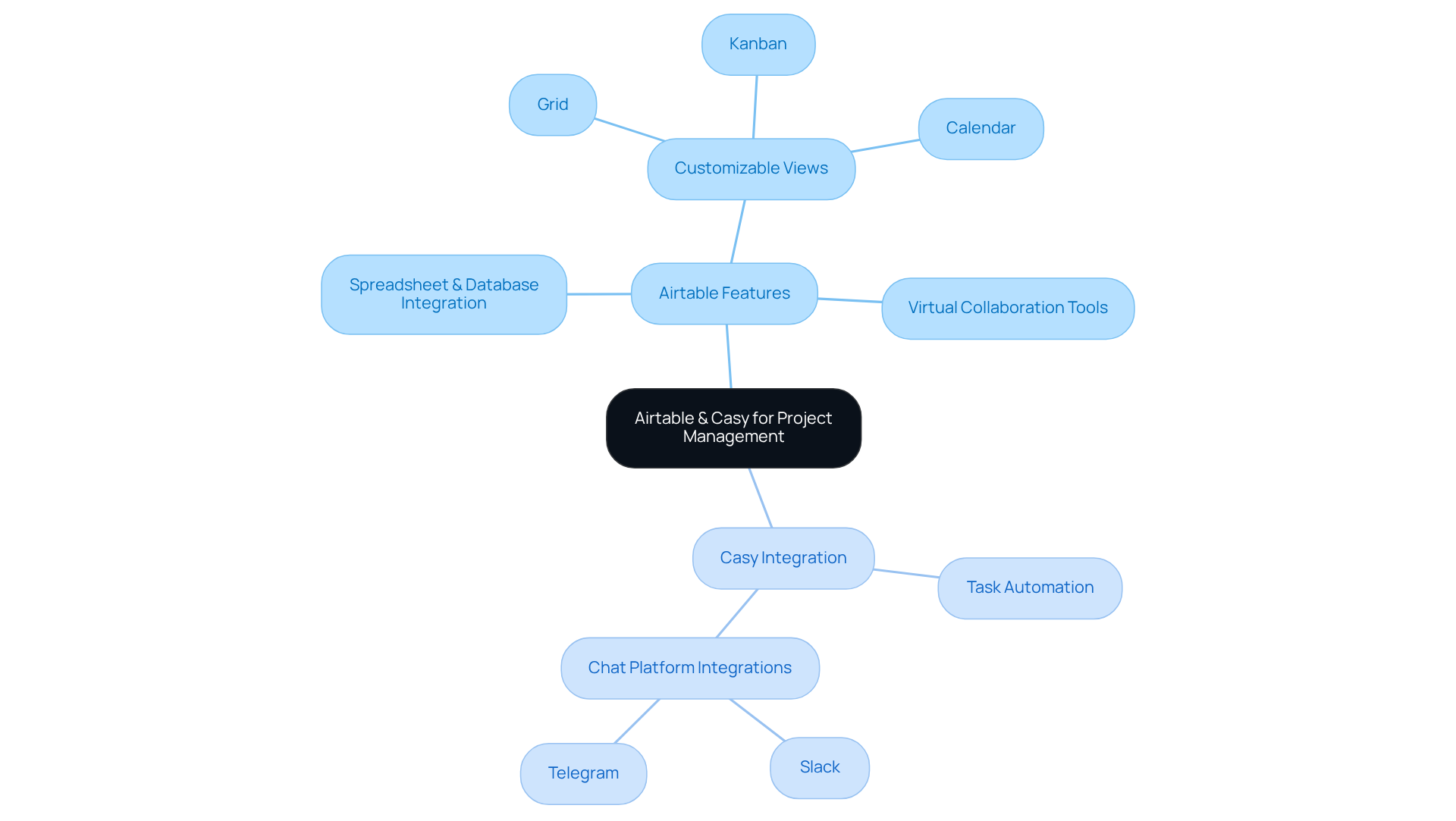
Conclusion
In a landscape where startups strive for efficiency and innovation, the right virtual collaboration tools can make all the difference. This article highlights ten essential tools that not only streamline communication and project management but also significantly boost productivity. By integrating these platforms into their workflows, startups can enhance collaboration, automate repetitive tasks, and ultimately focus on what truly matters: growth and innovation.
Key insights from the discussion include the transformative power of tools like Casy, which automates project management and task creation, and Slack, which enhances team communication through organized channels. Asana, Trello, Miro, Google Workspace, Zoom, Notion, Microsoft Teams, and Airtable each contribute unique functionalities that cater to the diverse needs of startups. These platforms facilitate real-time collaboration, improve task tracking, and foster a culture of creativity and efficiency, making them indispensable for new businesses aiming to thrive in competitive markets.
The significance of embracing these virtual collaboration tools cannot be overstated. As remote work becomes the norm, startups must leverage technology to overcome challenges and maximize their potential. By adopting these tools, founders can ensure their teams remain agile, connected, and productive. Exploring these options could unlock new pathways for success, enabling startups to not just survive but flourish in an ever-evolving business environment.
Frequently Asked Questions
What is Casy and how does it function?
Casy is an automated project management tool that integrates with platforms like Slack and Telegram to capture essential information from conversations. It generates assignments, establishes deadlines, and revises documents automatically, reducing manual input and enhancing group productivity.
What are some key features of Casy?
Key features of Casy include automated assignment creation, personal weekly scheduling, and categorization of activities into areas such as R&D, Bugs, and In Progress, which ensures full visibility for team members.
How does Casy benefit startups?
Casy helps startups optimize workflows, allowing teams to focus on innovation rather than administrative tasks. It can save founders up to 30 hours per week, enabling them to concentrate on strategic growth.
What methodologies does Casy employ to help teams prioritize work?
Casy utilizes methodologies such as OKRs (Objectives and Key Results) and the Eisenhower Matrix to help teams prioritize their work efficiently, ensuring that essential tasks are addressed promptly.
What commitment does Casy have regarding data privacy and security?
Casy is committed to data privacy and security, alleviating concerns for startups adopting new tools, making it a reliable choice for enhancing operational efficiency.
What role does Slack play in team communication?
Slack serves as a centralized hub for group communication, streamlining organized discussions through channels and direct messaging, and enhancing productivity with its robust integration capabilities.
How does Slack improve productivity?
Teams using Slack experience a 40% increase in productivity, as seen with the Spotify advertising group, which reduced unnecessary meetings and emails. Startups adopting Slack also report faster deal cycles and quicker ticket resolutions.
What are some notable features of Slack?
Notable features of Slack include Slack Huddles for quick meetings, customized workflows for optimizing repetitive tasks, and integration with over 6,400 applications to enhance productivity.
How is Asana utilized for task management?
Asana is a task management platform that allows teams to break down initiatives into manageable tasks, assign responsibilities, and establish deadlines, providing clarity on progress with visual task tracking features like Kanban boards and Gantt charts.
Why is Asana a good choice for startups?
Asana integrates seamlessly with other tools, making it an ideal choice for startups looking to optimize their management processes and elevate team productivity.




